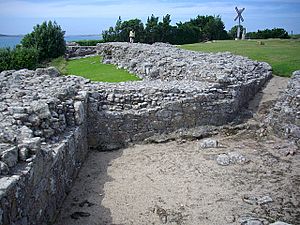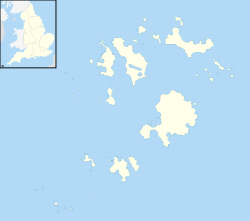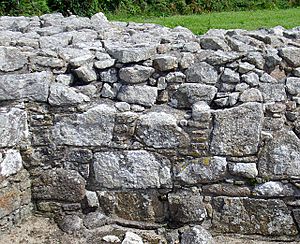Harry's Walls facts for kids
Quick facts for kids Harry's Walls |
|
|---|---|
| St Mary's in the Isles of Scilly | |

The remains of the south-west side
|
|
| Coordinates | 49°55′06″N 6°18′24″W / 49.91836°N 6.30674°W |
| Type | Artillery fort |
| Site information | |
| Owner | English Heritage |
| Open to the public |
Yes |
| Condition | Uncompleted |
| Site history | |
| Materials | Granite |
Harry's Walls are the ruins of a fort that was never finished. It was started in 1551 to protect the island of St Mary's in the Isles of Scilly. This fort was meant to guard Hugh Town harbour from possible attacks by the French. It was designed with a special "star-shaped" style, which was very modern for its time.
However, the fort was never completed, likely because there wasn't enough money or the danger of invasion passed. Today, only the south-west part of the fort remains. English Heritage looks after Harry's Walls, and you can visit them.
Contents
Why Was Harry's Walls Built?
In the 1500s, the Isles of Scilly were ruled by the King of England. These islands were very important because they were on the sea routes between Europe, Ireland, and Scotland. But they were also in danger from the armies of France and Spain.
King Henry VIII had built many forts, called Device programme forts, to protect England. But no forts were built on the Scilly Isles during his rule. After Henry died in 1547, his young son, Edward VI, became king.
Edward's government decided to build new defenses on the islands. At first, they focused on the island of Tresco. Later, they started building on St Mary's.
Starting the Fort in 1551
In May 1551, a man named John Killigrew was told to build a fort on St Mary's. The idea was to protect the entrance to the new harbour at Hugh Town. He was told to build it "upon the little hill betwixt the freshe water and St. Marie Roode."
The name "Harry's Walls" came from people mistakenly thinking King Henry VIII started it. But it was actually started by his son, Edward VI.
How Was the Fort Designed?
Plans from that time show that the fort was meant to be square. It would have had four pointed, "arrow-head" shaped bastions. These bastions had special protective parts called orillons.
Inside, there would have been living areas for the soldiers around a square courtyard. This design used new ideas from Italy, first seen in forts like Portsmouth and Yarmouth. Experts say it would have been the most advanced military building in England at that time.
In 1554, two small cannons, called sakers, were placed in the fort. Later, in 1554, during the time of Mary I, there was an attempt to get 150 men to the island. Part of their job was to help finish the fort.
Why Was Harry's Walls Never Finished?
Harry's Walls was never completed. Instead, a new fort called Star Castle was built in 1593. For a long time, people thought Harry's Walls was abandoned because it was built in a bad spot.
An old writer named William Borlase visited in 1752. He said the fort was "begun injudiciously" in a poor place. Another writer, John Troutbeck, said it would have been "of little use" even if finished. He thought it was too far inland to protect the harbour well.
New Ideas About Why It Was Abandoned
More recent studies suggest that the fort's location was actually good for protecting the harbour. It seems no single fort could have protected everything because of the islands' rocky coastline. Harry's Walls might have been planned to work with another fort.
The fort would have fit easily into its spot and been easy to defend. This was because it was surrounded by water and marshland. Instead, the main reason it wasn't finished was probably the very high cost. King Edward's government spent a lot of money on building forts across England. The project became too expensive, especially once the threat of a French invasion passed.
What Can You See Today?
Today, you can still see the south-west side of the fort. It includes two bastions and a connecting wall. These parts are made of granite blocks and rubble.
The pointed bastions are about 21 by 5 meters (69 by 16 feet) across and 2.3 meters (7.5 feet) high. The connecting wall is 27 meters (89 feet) long and 1.7 meters (5.6 feet) high. Some of the outer blocks have been taken away over time, showing the rubble inside.
There's also an unfinished defensive ditch outside the fort. It's about 25 meters (82 feet) long, 8 meters (26 feet) wide, and 1.2 meters (3.9 feet) deep.
Just north of the fort, you can find a very old standing stone. This stone was used long ago to help ships navigate. A modern navigational aid is now next to it.
English Heritage manages these remains today, and they are open for visitors to explore. Harry's Walls is protected under UK law as an ancient monument.




